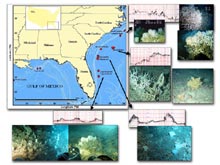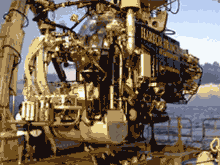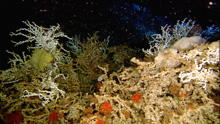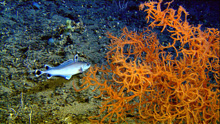
Figure 1. This map of the southeastern US and Gulf of Mexico shows our current study areas (red). The graphs above the pictures are from the research ship’s single beam sonar and illustrate the rough nature of the bottom. The pictures are representative of the areas and show a variety of mixed coral habitats. Note that these study sites are not the only locations of deep corals in the region; there are many more. Click image for larger view.
Figure 2. Manned submersibles (such as Johnson-Sea-Link shown here) are needed for exploring and sampling the deep, rugged bottoms of coral habitat. This submersible carries video cameras, still cameras, water quality measuring devices, and can retrieve samples using a suction device or a grabbing claw. On left is an evening recovery of the submersible and on the right Dr. S.W. Ross enters the sub for a morning dive. Click image for larger view.
The World of Deep-Sea Corals
Steve W. Ross,
Chief Scientist/Lead PI
Center for Marine Science, University of North Carolina at Wilmington and
US Geological Survey
![]() The alphonsino (Beryx decadactylus) is a common species on the deep coral habitats. (Quicktime, 348 Kb.)
The alphonsino (Beryx decadactylus) is a common species on the deep coral habitats. (Quicktime, 348 Kb.)
![]() Coral hake (Laemonema melanurum) swimming around a Lophelia coral head off North Carolina, about 375 meters deep. (Quicktime, 398 Kb.)
Coral hake (Laemonema melanurum) swimming around a Lophelia coral head off North Carolina, about 375 meters deep. (Quicktime, 398 Kb.)
![]() Large wreckfish (Polyprion americana), commercially important, patrolling along the flank of a deep coral mound. (Quicktime, 329 Kb.)
Large wreckfish (Polyprion americana), commercially important, patrolling along the flank of a deep coral mound. (Quicktime, 329 Kb.)
Nearly everyone has seen views of the colorful, large tropical coral reef systems and many have dived on them. But as few people are aware -- and far fewer have seen-- the deep, cold areas of the ocean are also home to coral-built habitats just as impressive as their tropical counterparts. Deep-sea or cold water corals have been known for hundreds of years, but aside from a few areas, they have been poorly studied. Usually existing in a world of darkness (the aphotic zone), these corals lack the symbiotic algae that populate (and help color) the shallow corals. However, increasing knowledge and evidence shows that deep-water corals are important as fish habitat, hold records on ocean climate and productivity (see Vaults of History essay), and are hotspots of biodiversity, including new species.
Deep coral habitats, more abundant than previously known, are at the same time being threatened by a number of activities, including mining, precious coral harvest, disposal activities, petroleum exploration and development, cable laying, gear damage, and fishing operations. The southeastern US (SEUS) and Gulf of Mexico may have the most extensive deep coral areas in the US; however, these large regions are minimally explored (even considering recent expeditions). Such unique habitats have escaped detailed examination in this region not only because of their great depths but also because the bottom topography is rugged and the habitats are overlain by extreme currents (i.e., Gulf Stream). Thus, most studies on deep coral banks require expensive and unconventional sampling techniques, such as manned submersibles. This year, as in the past five years, we will take advantage of manned submersible technology to explore coral banks in this area, studying both the habitats and the animal communities they support (see Mission Plan).
The Coral Habitats
Deep coral reefs seem to have similar habitat functions as shallow coral reefs (increased faunal diversity, concentrated foods, and obligate fauna). There are over 100 deep coral species on the continental slope of the southeastern US, starting at depths around 360 meters with most no deeper than 1000 meters. While many species contribute to habitat structure and complexity, few species create extensive, complex reef structures. Lophelia pertusa, the major hermatypic (mound building) coral in the deep sea, occurs not only on the SEUS slope (where it is the dominant hard coral), but also in the Gulf of Mexico, off Nova Scotia, in the northeastern Atlantic, the South Atlantic, the Mediterranean, Indian Ocean and in parts of the Pacific Ocean over a depth range of 50 to 2170 meters. It always prefers cold waters, thus the shallower end of its depth range is in areas of constantly cold temperatures (Scandinavia, for example). Although Lophelia may occur in small, scattered colonies attached to various hard substrates, it also forms high profile features, some rising as much as 100 meters from the surrounding substrate. These structures can accelerate bottom currents which are favorable to attached filter-feeding invertebrates and other biota. The rubble zones of dead, broken coral pieces may be extensive in some areas, and also provide habitat to various animals.
The exact mechanisms for development of coral mounds or extensive deep coral habitat are debated. The mounds off North Carolina and those in some other SEUS locations (particularly off Florida) appear to be formed by successive coral growth, collapse, and sediment entrapment. Other coral formations in the area (especially on the Blake Plateau) seem to be formed by coral colonization of hard substrates, without mound formation by the corals. Assuming currents carry appropriate foods, it may be that currents with moderate speeds (fast enough to aid filter feeding but not too fast to prevent sediment entrapment) coupled with a supply of sediment are the conditions necessary for coral mound formation. Regardless of how they are formed, elevated topography appears to be an important attribute for well-developed coral communities. We have concentrated our work around L. pertusa areas because of its abundance, wide distribution, and structure forming abilities, but our objectives are applicable to most hard substrate habitats including mixed corals and sponges that occur throughout the region.
Although Lophelia is the dominant hard coral on the Blake Plateau, other hard corals contribute to the overall complexity of the habitat. These include the colonial corals Madrepora oculata and Enallopsammia spp. as well as a variety of solitary corals. These hard corals tend not to occur singly or as species-specific mounds, but rather live on or within the Lophelia matrix. Overall, species diversity of hard corals seems to increase south of Cape Fear, NC. Bamboo and black corals are also important structure forming corals in the SEUS. These corals occur locally in moderate abundances, but their distributions seem limited to the region south of Cape Fear, NC. Colonies may reach heights of 1-2 meters. Bamboo and black coral colonies, occurring either singly or in small aggregations, may be observed either in association with hard coral colonies or as separate entities. Attached sponges add to this mix of living habitats as well.
Deep Coral Fauna of the Southeastern US (SEUS)
Deep-water coral habitat may be more important to western Atlantic slope
species than previously known. Some commercially-exploited deep-water fishes,
like wreckfish (Polyprion americanus) and blackbelly rosefish
(Helicolenus
dactylopterus), congregate around Lophelia habitat (![]() See
a video of the wreckfish - Polyprion americana). Other potentially
exploitable species are also associated with deep corals (royal red shrimps,
rock crabs, bericiform fish species, eels). Fish studies related to the
deep coral banks are almost non-existent. Initially, the most impressive
biological aspect of these coral mounds, aside from the corals themselves,
was the well-developed and abundant invertebrate fauna. Various crabs are
abundant on these deep reefs, playing roles of both predator on and food
for the fishes. Other invertebrates, particularly urchins and sea stars
also populate the coral matrix in high numbers. See essay by M. Nizinski
for details of coral bank invertebrates.
The coral habitat offers abundant shelter and food resources.
See
a video of the wreckfish - Polyprion americana). Other potentially
exploitable species are also associated with deep corals (royal red shrimps,
rock crabs, bericiform fish species, eels). Fish studies related to the
deep coral banks are almost non-existent. Initially, the most impressive
biological aspect of these coral mounds, aside from the corals themselves,
was the well-developed and abundant invertebrate fauna. Various crabs are
abundant on these deep reefs, playing roles of both predator on and food
for the fishes. Other invertebrates, particularly urchins and sea stars
also populate the coral matrix in high numbers. See essay by M. Nizinski
for details of coral bank invertebrates.
The coral habitat offers abundant shelter and food resources.
So far, we have identified over 70 bottom or near-bottom fish species
on and around these coral banks, but over most of the area we have
sampled, about 11 fish species dominate. Our preliminary results suggest
that some of the fishes observed around the deep coral habitats may
require the reef habitat, much as the shallow coral reef fishes do.
Large, bright red Beryx decadactylus (alphonsino) usually occurs in
aggregations moving over the reef (![]() See a video of Beryx decadactylus), while most other major species occur
as single individuals. Many of these species are well hidden deep in
the corals (e.g., Hoplostethus occidentalis, Nettenchelys
exoria, Conger
oceanicus). The morid (a cod relative), Laemonema
melanurum, is one
of the larger fishes abundant at every site with corals. This fish
seems to rarely leave the prime reef areas, and for that reason we
call it the “coral hake” (
See a video of Beryx decadactylus), while most other major species occur
as single individuals. Many of these species are well hidden deep in
the corals (e.g., Hoplostethus occidentalis, Nettenchelys
exoria, Conger
oceanicus). The morid (a cod relative), Laemonema
melanurum, is one
of the larger fishes abundant at every site with corals. This fish
seems to rarely leave the prime reef areas, and for that reason we
call it the “coral hake” (![]() See a video of Coral hake). Its close relative (Laemonema
barbatulum) seems to roam over a larger, often non-coral territory.
Although blackbelly rosefish can be common in all habitats, it clearly
occurs most often around structures and is very abundant around deep
reef habitat. Two unexpected results we have documented in our fish
work is that several species thought to be rare are in fact common
here, and we have seen a number of species outside of their normally
reported ranges.
See a video of Coral hake). Its close relative (Laemonema
barbatulum) seems to roam over a larger, often non-coral territory.
Although blackbelly rosefish can be common in all habitats, it clearly
occurs most often around structures and is very abundant around deep
reef habitat. Two unexpected results we have documented in our fish
work is that several species thought to be rare are in fact common
here, and we have seen a number of species outside of their normally
reported ranges.
On the taller coral mounds, it is common to see fishes and invertebrates that normally occur only in midwater depths, such as hatchetfishes, lanternfishes, squids, shrimps, and krill. Most of these animals undergo well-known migrations up toward the surface at night and back down to depth at dawn. In these continental slope depths, as these animals move downward, they often impact the bottom where they may feed and themselves provide a food source to predators in the coral habitat. Some of these species may give up the daily migrations to stay on these resource rich bottom habitats. We are exploring the extent to which these animals form an important ecological link between different areas of the water column (see Surface to Bottom essay).






























